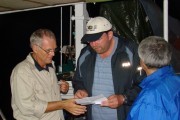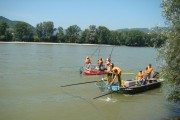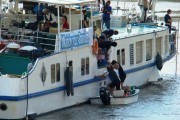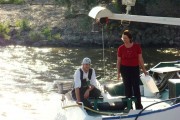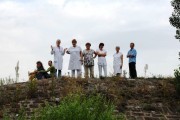
For the Tisza, getting to the first sampling station required a small team of Hungarian scientists to start a trek on August 29, travelling by car over 300 km up the Tisza from its confluence with the Danube. This was followed by sampling at two more Tisza stations, and the samples then needed to be transported to the fridges on-board the Argus the same day they were taken from the river - otherwise they would warm up and go bad. In total, 14 Hungarian scientists were part of the National Team, many of which also helped out with the time-consuming job of sieving through sediment samples on-board.
"The work of the National Teams is a very serious activity parallel to the JDS2 work," says JDS2 Technical Coordinator Jaroslav Slobodnik. "Besides providing us with valuable assistance on the JDS2 boats, National Teams take samples at tributaries in their countries. They also sample at some of the same places where the JDS2 samples, then testing them at their own national labs. The results from the national and JDS2 labs can then be compared, which is important to ensure result and test validity."
The JDS2 school
The JDS2 is also something of a school for the scientists to learn each other's methods, some of which are quite new. "The JDS2 is training them in many techniques," says JDS2 Team Leader Béla Csányi. "For example, the Hungarian team learned about the complex process required by the EU to get samples and transport them to labs. It was also the first time they saw the sediment air-lift sampler in action."
Csányi adds his satisfaction that he witnessed no differences among any of the scientists, regardless of what country they were from, regarding their interest in and cooperation with the JDS2. Slobodnik adds that National Team scientists are always there to greet the JDS2 boats as they arrive to the borders of a new country, often coming on board to start helping with the day's work.
On August 21, a special multinational meeting was held in Slovakia next to Devin Castle, where a monument stands in honour of people killed by the former regime when trying to escape to Austria at the former Iron Curtain border. As the meeting place between the countries of Austria, Slovakia and Czech Republic, it was also an ideal location for the National Teams of each of the three countries to meet with the JDS2 as it passed from West to East, with friendly border police on hand to guide them.
"One of my best memories is of Matus Haviar from Slovakia who immediately jumped into the heaviest and dirtiest jobs for us," says Csányi. "At that time, the whole team was half-dead and we couldn't have managed without his help. Another memory was when we passed from Germany to Austria and realized we had to say goodbye to the German National Team, and what a sorry moment that was for us all."












